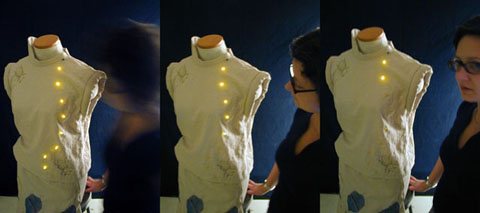






|
Memory Rich Clothing: Garments that Display their History of Use (or Second Skins that Communicate Physical Memory) Physical objects become worn over time. A worn object carries the evidence of our identity and our history. Digital technologies allow us to shape and edit that evidence to reflect more subtle, or more poetic, aspects of our identity and our history. This project focuses on the research and development of reactive garments that will display their history of use. We will employ a variety of input and output methodologies to sense and display traces of physical memory on clothing. Objectives: To develop technical and conceptual prototypes that explore how physical memory can be communicated through our clothing. Physical Memory refers to the fact that the objects will retain some traces of presence of the user, through the ability to sense the user and record a history of interaction that can be communicated to another user. Initial research concepts include personal health monitoring, mood monitoring, wearable diaries, and communicating remote presence. We will ask, how can an object have "memory"? How can an object be altered through interaction? What kind of interactions will be necessary to give physical memory to a wearable object? What is the difference between PASSIVE and ACTIVE interaction (manipulation versus sensing)? Who do we want to communicate with or to? |
Examples: (1) An Intimate Memory shirt with a very sensitive microphone in the collar and a series of light points in a flower pattern incorporated into the front of the shirt. When a friend or partner whispers something into your ear, the microphone will record this event and the lights will light up, showing that an intimate event has occurred. The number of lights indicates the intensity of the intimacy event. Over time, the lights turn off, one by one, to show how long it has been since the intimate event took place.  (2) A skirt with touch sensors incorporated into the design. During the course of the day, the skirt will record each touch event, and it will gradually start changing color to show how often it has come into contact with other people or objects. In the evening, it will display a history of its daily physical contact. Context: Digital technologies enable us to capture, store, and catalogue an ever-increasing amount of information about ourselves, including digital images, video, and audio as well as text-based data such as emails, blogs, and Web browsing histories. In the future, pervasive computing environments will become a strong infrastructure to capture our experiences through networked ubiquitous sensors that record various aspects our activities. At the same time, scientists are receiving increasing amounts of funding to research technologies such as "remembrance agents" and personal digital assistants that will help us track our appointments, commitments, and important life details. One of the potential killer apps for wearable computing is a piece of software that will help the user remember people's faces and names, and retrieve details associated with previous encounters as well as other relevant information from the Web. Software research directions also include multimodal memory aids, context recognition, the modeling of lifestyle patterns, and personal storytelling. There are similarly many hardware research projects that look into ubiquitous sensor networks and wearable devices for personal event recording and computer supported cooperative work. |